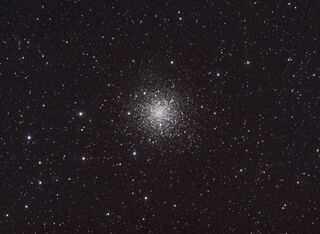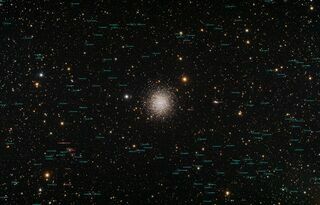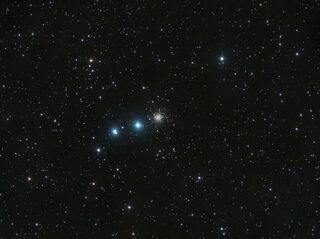
- Constellation: Ophiuchus
- Right Ascension: 16h 47m 14.18s
- Declination: –01° 56′ 54.7″
- Distance: 15,700 ly
Messier 12 is a globular cluster located in Ophiuchus. Spanning 75 light years across and is a loosely concentrated globular cluster. It contains around 200,000 stars but contains relative few amount of low mass stars, which may have been stripped out due to gravitational interaction with the Milky Way Galaxy.
- Details
- Category: Globular Clusters
- Telescope: Explore Scientific 127 Refractor
- Camera: ZWO 1600 MM

- Constellation: Scorpius
- Right Ascension: 16h 23m 35.22s
- Declination: –26° 31′ 32.7″
- Distance: 7,200 ly
Messier 4, a globular cluster located in Scorpius. It contains more than 20,000 stars, which is less that most globular clusters, but as it passes through the plane of the Milky Way, it may have shed stars with each passage. And at 7,200 light years away, it is one of the closer ones. As it lies near the bright star Antares, it is relatively easy to find in the sky. Antares itself is embedded in a nebula in which the outer parts can be seen in the lower left. M4 has a distinctive bar feature of stars across its middle. In 2003 a Jovian plus sized planet was discovered orbiting a binary star that consists of white dwarf and a neutron star outside of M4's core. The planet is thought to be 12.7 billion years old as the globular itself is thought to be over 12 billion years old.
- Details
- Category: Globular Clusters
- Telescope: EDT 80mm Reftactor
- Camera: ZWO A071 Color

- Constellation: Hercules
- Right Ascension: 16h 41m 41.24s
- Declination: +36° 27′ 35.5″
- Distance: 22,200 ly
Messier 13 is located in the constellation of Hercules naturally. It contains an estimated 300,000 stars and is located some 22,000 light years away, with an estimated age of 11.6 billion years old.
- Details
- Category: Globular Clusters
- Telescope: EDT 80mm Reftactor
- Camera: ZWO A071 Color

- Constellation: Canes Venatici
- Right Ascension: 13h 42m 11.62s
- Declination: +28° 22′ 38.2″
- Distance: 34,000 ly
Messier 3 is a globular cluster located in the constellation of Canes Venatici. It contains an estimated 500,000 stars and is one of the brighter and largest of the 250 or so globular located around our galaxy.
- Details
- Category: Globular Clusters
- Telescope: EDT 80mm Reftactor
- Camera: ZWO A071 Color

- Constellation: Coma Berenices
- Right Ascension: 13h 12m 55.25s
- Declination: +18° 10′ 05.4″
- Distance: 58,000
Messier 53 a globular cluster located in the constellation of Coma Berenices at a distance of 58,000 light years away. A very metal poor cluster indicating that most of the stars are of a first generation as stars that are formed from the deaths of other stars have higher levels of metal in them. The cluster contains more than 500,000 stars and 67+ of the RR Lyrae type of variable stars that are used to estimate the distance much like Cepheid variables are.
- Details
- Category: Globular Clusters
- Telescope: Explore Scientific 127 Refractor
- Camera: ZWO 1600 MM

- Constellation: Lynx
- Right Ascension: 07h 38m 08.51s
- Declination: +38° 52′ 54.9″
- Distance: 300,000 ly
NGC 2419, often called the Intergalactic Wanderer because of the 300,000 light years distance from our galaxy. Originally not thought to be gravitational bound to our galaxy, it now thought to be in orbit around our galaxy and takes about three billion years to complete one orbit. If not for its extreme distance, it would be one of the brightest globular clusters in the night sky, as it is one of the most massive globular clusters that orbit our galaxy.
- Details
- Category: Globular Clusters
- Telescope: Explore Scientific 127 Refractor
- Camera: ZWO 1600 MM